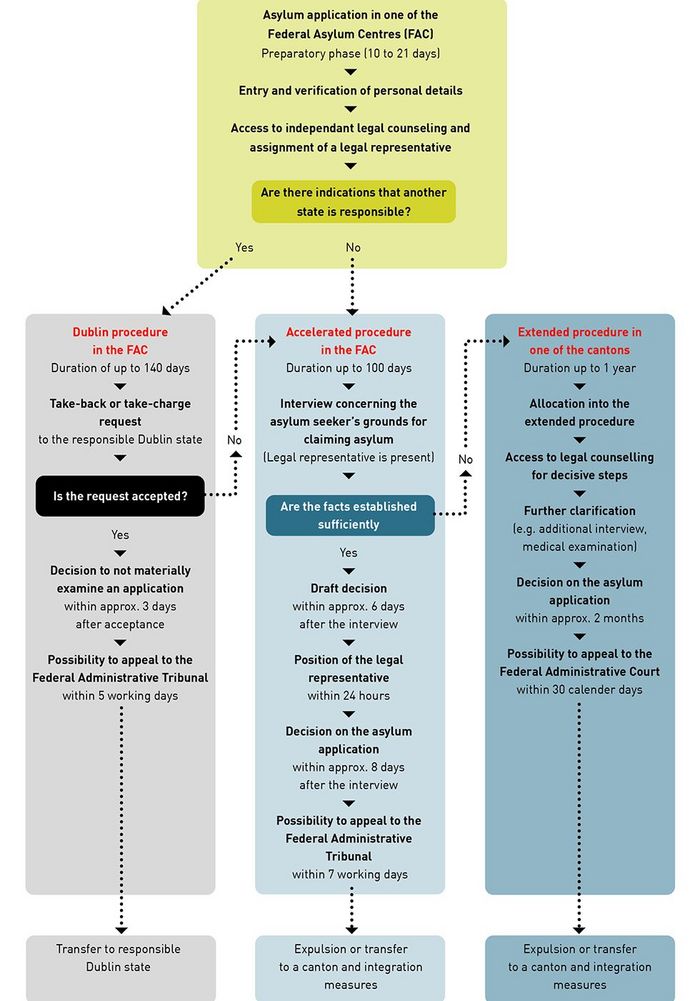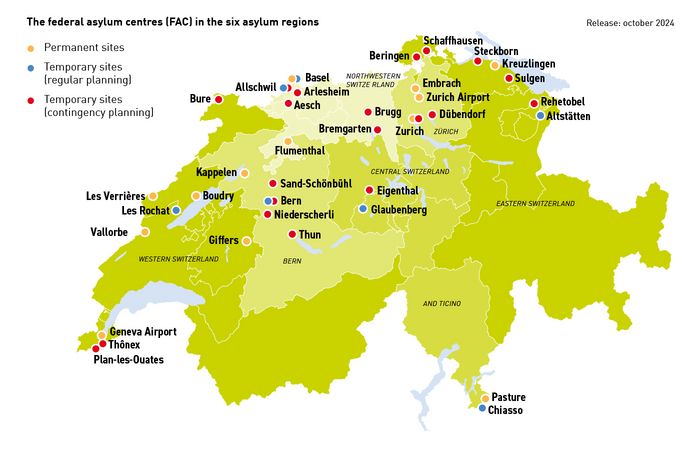The new asylum procedure came into force in Switzerland in March 2019. From this point on, procedures are accelerated and decentralised into federal asylum centres. Asylum seekers processed under the new procedures also receive advice and legal representation. All asylum applications submitted by 28.02.2019 are being processed under the asylum procedure that was in force until 28 February 2019.
The following chart depicts the accelerated asylum procedure in force since March 2019.

Each stage of the asylum procedure is explained below.
Asylum application
An application for asylum is any declaration made by a foreign person indicating that he or she is seeking, in Switzerland, protection from persecution. Without an asylum application there can be no asylum procedure. In contrast to the asylum procedure, no formal criteria apply to the application itself. It can be submitted orally or in writing.
All asylum seekers are assigned to a federal asylum centre with processing facilities, run by the Federal government in six asylum regions: Altstätten (Eastern Switzerland asylum region), Basel (Northwest Switzerland asylum region), Balerna and Novazzano [until further notice Chiasso] (Central Switzerland and Ticino asylum region), Bern (Bern asylum region), Boudry (Western Switzerland asylum region) and Zurich (Zurich asylum region).

Image: State Secretariat for Migration, Octobre 2024
Special cases: Humanitarian visa or resettlement program
The option to submit an asylum application at a Swiss embassy in another country was abolished in 2012.
The humanitarian visa offers a possibility to enter Switzerland for humanitarian reasons. This type of visa application is usually only possible in the country of origin, not in third countries.
In practice, Switzerland issues very few humanitarian visa regulation and interprets the criteria in a very narrow way: the person must be under an immediate, serious and real threat to life and limb.
The resettlement program is also possible for selected groups of people from certain regions of the world.
Special case: Airport procedure
Special rules apply to the asylum procedure if a person enters Switzerland via Zurich or Geneva airport and submits his/her asylum application in the airport’ transit area (Art 22 and 23 AsylA). In these cases, the State Secretariat for Migration first decides whether to grant, or provisionally refuse, entry into Switzerland. Under the airport procedure, the asylum and appeal procedures can be carried out in the airport's transit area.
Preparatory phase
Once the asylum application has been submitted, the preparatory phase begins.
The preparatory phase lasts 10 days under the Dublin procedure and 21 days under all other procedures. During this period, the asylum seeker’s personal details are recorded. Fingerprints are taken and compared with the European database and other biometric data is also collected. The SEM checks the evidence, i.e. travel and identity documents. The authorities may launch additional investigations into the asylum seeker’s origin and identity. Medical facts are clarified if a person claims to have health issues.
In the preparatory phase, asylum seekers are given free advice about the steps involved in the asylum procedure as well as their rights and obligations, all during a one-on-one interview. Asylum seekers are also able to ask the advisory staff questions and request further information at an assistance desk.
The first interview with the legal representative is used to establish mutual trust and prepare for the initial procedural steps.
If the asylum seeker is an unaccompanied minor, the first step in the procedure is a brief initial interview.
The vast majority of adult asylum seekers undergo a Dublin interview. During this interview, the SEM examines whether another State is responsible for processing the asylum application under the Dublin system. This responsibility can be determined via fingerprints taken in another State, statements made by the asylum seeker during the interview as well as previous visas. During the interview, the asylum seeker is given an opportunity to express his or her views and will also be asked whether there are grounds for not transferring him or her to the State responsible for processing their application (called the 'right to be heard').
A decision is then taken on whether to apply the Dublin procedure or the accelerated procedure.
The initial interview and the Dublin interview are the asylum seeker's first official interviews with the SEM.
The Dublin procedure
After the Dublin interview, the SEM decides whether to examine the content of the asylum application. A take-over request is submitted if it is found that this examination is the responsibility of another European State. If the other State is prepared to examine the asylum application, or does not reply within a given time period, this State will be responsible for the asylum application. Switzerland generally has six months to perform the transfer. If a person disappears, the period is extended to 18 months.
If Switzerland is not responsible for examining the asylum application, the SEM rejects the application or issues a so-called non-admission decision (NEE).
In certain cases, Switzerland may, for humanitarian reasons, declare itself responsible and assume responsibility for examining the asylum application. Switzerland is obliged to examine the application itself if systemic flaws mean that the person is threatened with inhumane or degrading treatment in the other Dublin State.
A non-admission decision is also taken if the asylum seeker is able to return to a so-called safe third country (e.g. because he or she already has a residence permit there).
Accelerated asylum procedure
If Switzerland is responsible for examining an asylum application, the SEM initiates the national accelerated asylum procedure. Under the accelerated procedure, asylum seekers can describe their reasons for flight in detail during a hearing and provide the authorities with evidence (police summons, court decisions, medical certificates, photos, newspaper articles, etc.). All relevant issues must be examined. The hearing and any possible evidence are used to determine the asylum decision. The SEM hearing occurs in the presence of the asylum seeker's legal representative.
After the interview, the authority examines whether the asylum seeker meets the status of a refugee, whether he or she will be granted asylum or whether there are other reasons why the person is unable to return to his or her home country or country of origin. If the facts are clear, an asylum decision will be made within eight working days at the federal asylum centre.
In April 2024, the 24-hour procedure was introduced throughout Switzerland for individuals from the Maghreb countries. The aim was to process asylum applications more quickly and reduce the overall number of applications from this region. As a result, the 24-hour procedure leads to different treatment of asylum seekers based on their origin. Further information on the 24-hour procedure and the position of the SRC can be found here (in german and french).
Extended procedure
Asylum seekers whose applications for asylum cannot be decided straight after the interview because further clarification is required will be assigned to the extended procedure. The Federal government assigns these persons to a canton, which is responsible for their accommodation and care throughout the procedure.
During this procedure, the asylum seeker can seek support from a designated legal advice centre in the same canton. In exceptional cases, if a special relationship of trust exists, the legal representation of the Federal Asylum Center remains responsible. This extended procedure lasts for a maximum of one year and ends once an asylum decision has been issued.
Asylum decision: Protection status or expulsion
The SEM has various options when it comes to asylum-status determination.
If the decision is positive, the person is recognised as a refugee and granted asylum. He or she may stay in Switzerland and receives a B permit. If the decision is negative, the person must leave Switzerland, unless there are obstacles to removal. In this case, the person is issued with a residence permit as a provisionally admitted as foreigner or refugee. If the asylum procedure was only submitted for economic or medical reasons, or if the person falls under the responsibility of another State, the SEM issues a non-admission decision with expulsion from Switzerland.
More information on asylum status can be found here.
Appeal against the asylum decision
If a person has not been granted protection, he or she may appeal to the Federal Administrative Court within the appeal time limit. Under the Dublin and accelerated procedures, while in a federal asylum centre, the asylum seeker can be represented by their assigned legal representative, unless the legal representative decides to terminate their role because the appeal has little chance of success. With the extended procedure, free legal representation is not provided for appeals. The asylum seeker or a representative, such as an employee of the legal advice centre, can apply for free legal assistance and representation in the event of an appeal.
The time limit for appeal is five working days under the Dublin procedures and seven working days under the accelerated procedures. Under the extended procedure the appeal time limit is 30 calendar days. The Federal Administrative Court acts as the first and last court of appeal. This means that a person can only appeal against a negative asylum decision once. Exceptions are application for reconsideration or revision, but these are rarely successful in practice.


![[Translate to Englisch:] Herkunftslaenderberichte](/fileadmin/_processed_/e/b/csm_Herkunftslaenderberichte_997d5a1346.jpg)